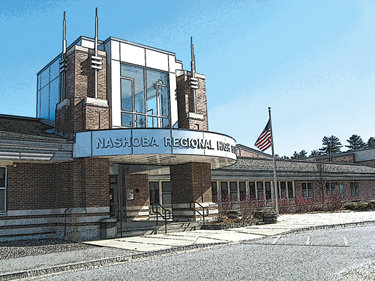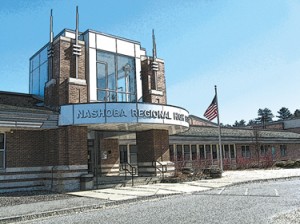
by Ann Needle
If last Wednesday’s Tri-Town Town meeting at the Stow Town Building is any sign of what’s to come for the Nashoba District, 2015 promises lots of debate on how to expand Nashoba Regional High School.
“I want to caution everyone that we are not [set on] building a new high school — we may never build a new high school,” maintained Bolton School Committee Rep. Lorraine Romasco. But, she reminded the approximately 25 attendees— including selectmen, SC members, and residents of Nashoba’s three towns — that the student population since the last NRHS renovation has jumped from 800 to more than 1,000, so, “The opportunities for wiggle room just aren’t there.”
The NRHS Space Task Force’s Bob Czekanski of Bolton said the Task Force is still collecting data on factors such as the number of students forced to take study periods in the hallways and cafeteria, and how many students are being denied certain classes. The Task Force aims to agree on an interim report on these findings at its next meeting, he said.
Answering Stow Board of Selectman Brian Burke’s question, Czekanski explained to the audience why Space Study will not directly address the question of eliminating school choice to help free up space. School choice allows up to 25 out-of-district students per class to attend NRHS. The program is currently at its 100-student capacity.
“My understanding of the [Task Force] charter is to only consider existing decisions, existing policies,” Czekanski said. “If we go back and review established policies on school choice, we would have to review other policies. I don’t think that’s a fruitful path to go down.”
Stow resident Bill Byron, declaring he was never a school choice fan, asserted that 25 students in each grade could be enough to shut a substantial number of district students out of classes. Czekanski responded, “There’s no way to know that.” David Lindsay of Bolton asserted that Nashoba isn’t likely to get the needed town meeting votes for any large-scale expansion if administration publicly views school choice as “just another policy.”
But, Lorraine Romasco pointed out that shutting down school choice wouldn’t have an immediate impact, given choice students can stay until graduation, even if the program is closed to new students.
Asked about the latest projections for student enrollment, Superintendent Michael Wood said the district would have a better idea in about a month. Lindsay cautioned against using these numbers, claiming that enrollment calculations completed before the previous renovation vastly overestimated future capacity to the point where, today, “We would have this big, empty building.”
The Pompo Modular
In more immediate plans to expand high school space, SC Rep. Lynn Colletti of Stow said she had heard that the portable, two-classroom modular the SC voted to accept as a donation from the town of Stow was “promised somewhere else.” The modular was part of the former Pompositticut School.
Stow Selectman Don Hawkes explained that, in working on renovation plans for the Pine Bluff Recreation Area, Stow’s Recreation Commission was urged to look into accepting the unit. “But, if it can alleviate the space problems at the high school, that’s the place for it. And second, the Rec Commission doesn’t want it,” he wryly remarked. Wood reiterated that Nashoba is still quite interested in accepting the unit.
Stow SC Rep. Maureen Busch asked if there were any upcoming capital projects among the three towns that could influence how much the district should request from voters. Though Nashoba and town representatives said they didn’t know of any debt exclusions to be requested — except for the Pompo conversion — Lancaster Selectman Jennifer Leone cautioned that Minuteman High School’s planned overhaul, estimated at about $125 million, could eventually be on ballots, though probably not in the next year. (Tri-Town is requesting Minuteman send a representative to its next meeting with an update.)
In another topic of ongoing interest, Bolton Selectman Stan Wysocki questioned how Nashoba plans to improve the high school’s rankings among surrounding districts. He noted that, using the state’s “proficiency rating” — which blends several pieces of data on a school into a single number — NRHS’s has been lower than some of the surrounding towns, including Acton-Boxborough and Harvard’s Bromfield School.
Wood replied that the district has invested over recent years in shoring up its programs for at-risk students. Meanwhile, David Lindsay commented that SAT and MCAS scores might be more understandable measures of Nashoba’s success, given, “It sometimes appears three-quarters of potential home buyers consider their children above average.”
Regardless of how Nashoba measures the high school’s progress, Wysocki said, “I’m hearing from a lot of residents — where is the accountability, what is in the accountability? In business, that’s sort of the norm.”